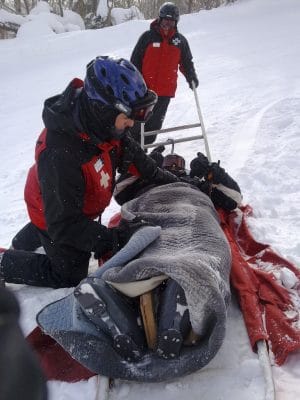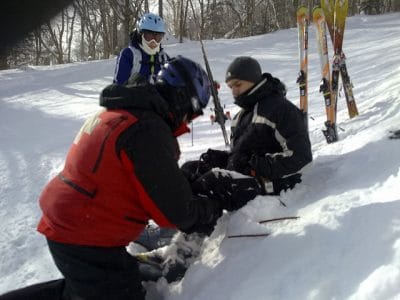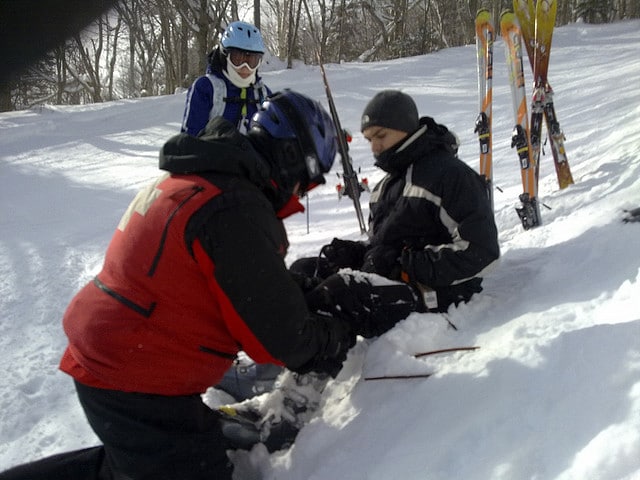It’s a beautiful day, the sun is shining, the powder is fresh and deep, and you’re headed down the slope. You see the jump you’ve always wanted to hit and decide that today’s the day. You’re soaring through the air, feeling great, when all of a sudden, WHAM. You’re down and injured.
Skiing can be a very dangerous sport if you don’t take the necessary precautions.
Here, we teach you how to prepare and guard yourself against injuries, as well as what to do in the event of an injury.

Table of Contents
Know the Risks
Knee Injuries
The most common type of injury for skiers is knee-related injury. With all the twisting, shifting, sudden stopping, and turning, knees take a lot of strain from skiing. According to Move Forward Physical Therapy, knee sprains (including ACL and/or MCL tears), account for about 30% of all skiing injuries.
A medial collateral ligament (MCL) tear is the most common. An MCL tear occurs when the tissue on the inside of your knee is torn. In skiing, the MCL is often torn when the ski tips are pointed toward one another in a snowplow position (the common slowing or stopping position) and the skier falls down the hill. MCL tears are more common among beginning and intermediate skiers than advanced and elite skiers.
An anterior cruciate ligament (ACL) tear is the second most common knee injury. This injury comes from overstretching or tearing this ligament. According to Medline Plus, this can be caused by overextending the knee joint, quickly stopping and changing direction while running, landing from a jump, or turning.
Head Injuries
Another common form of ski injury is head injury. The first type of head injury is from collisions, either with other skiers, or with other objects, like trees.
Another common form of head injury comes from impact with snow or ice from jumping, falling, or speed.
A lack of attention while riding lifts can result in head injuries as well.
Prevention
1. Proper equipment
Always wear a helmet and other protective gear. It’s simply not worth it to go without. Make sure that your equipment fits well and is well made. Wear padded clothing. Make sure your helmet is snug across your head.
2. Proper Technique
Keep your weight and arms forward, legs parallel, and hips above knees. Most of all, maintain balance and control.
3. Stay on Marked Trails
As tempting as it might be to go ski through the beauty of the trees and seek out fresh powder, it is not worth the risk of injury. Stay on marked trails, or if you must go into ungroomed territory, be extra careful.
4. Exercise your body
Make sure to exercise before skiing, including stretching and aerobic exercises such as walking, running, the elliptical, or biking.
5. Don’t push yourself too hard
Don’t ski when you’re tired. Give yourself sufficient time in between ski days to let your body rest and restore. Don’t take stupid risks, and always be on the lookout for hidden dangers. Don’t attempt something you know is out of your skill range.
6. Use the buddy system
Don’t ski solo. Ski with a friend and keep yourself in each others sights at all times.
What to Do if Injured:
If you are injured:
Stay calm and try not to panic. If you can, try to flag down a nearby skier and ask them to go send for help. Tell ski patrol exactly what has happened and if any other skiers or snowboarders that were involved.
Take pictures or have your friend take pictures of the scene of the accident in case you need to present evidence later.
If someone else is injured:
If you see someone injured on the slopes, don’t leave them alone. Instead, flag someone else to go and get ski patrol or flag down ski patrol yourself if possible. Don’t move the injured person. Tell them to stay calm, and that help is on its way.
If you are unable to flag someone down, stand your skis upright to form an X, which lets passerby know that you are in need of help.
When ski patrol arrives, let them know what has happened to the best of your ability.
Photo 1 copyright to William J Sisti
Photo 2 copyright to Mt. Hood Territory
Photo 3 copyright to William J Sisti
